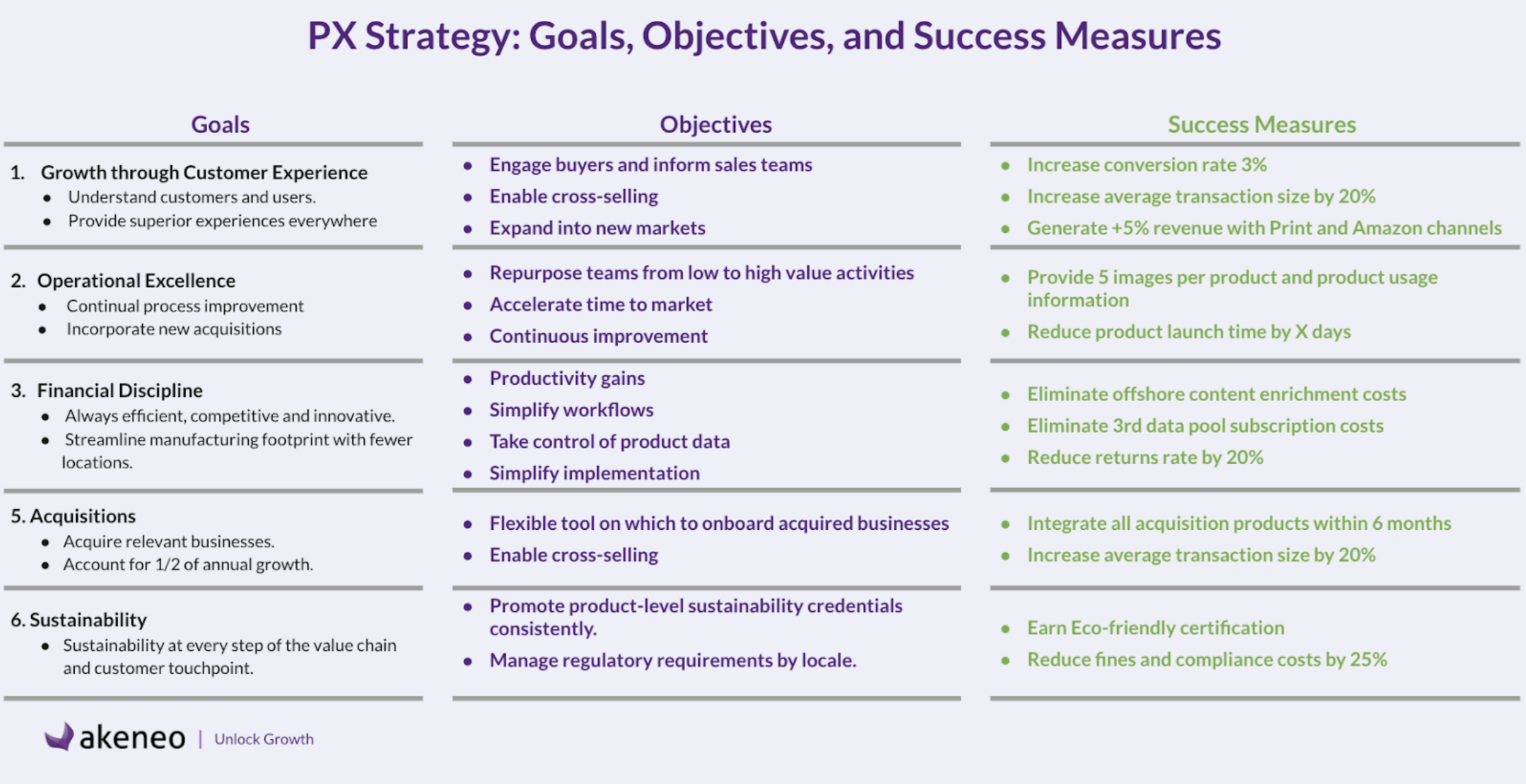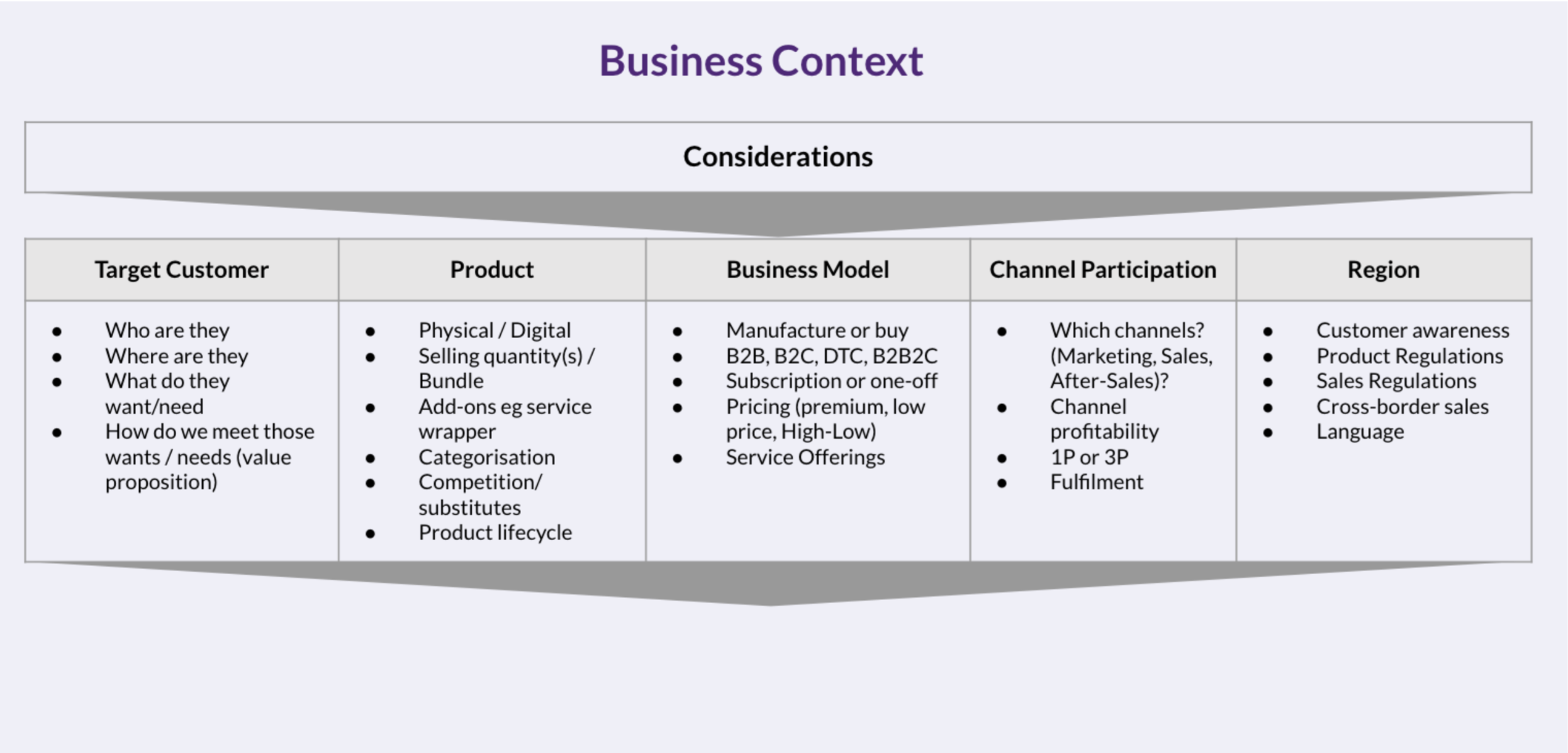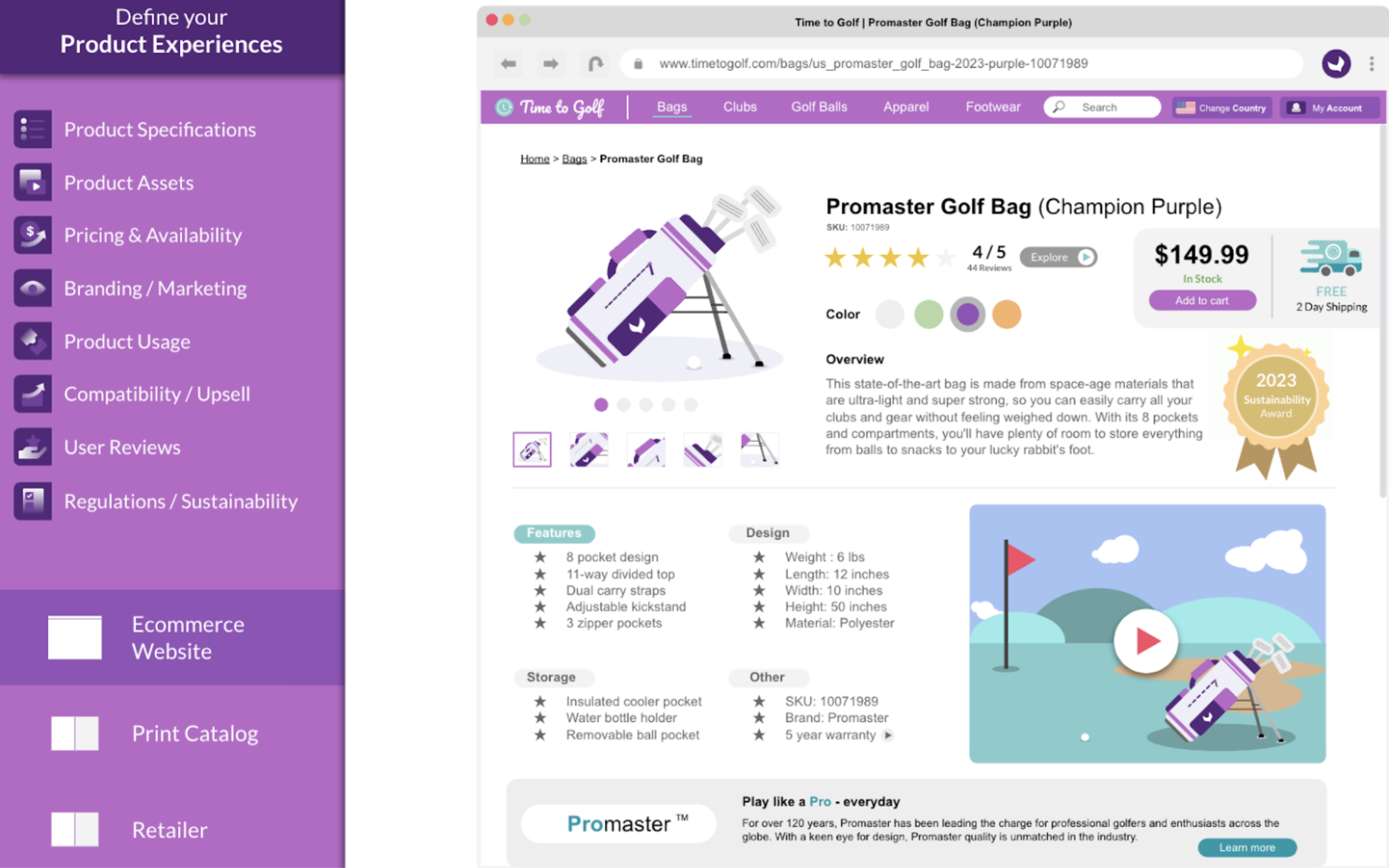Product catalogs must be shared with customers across sales channels, marketing streams, and languages, which often requires alignment of both siloed teams and disjointed supplier relationships, and streamlined processes for search optimization, translations, and copywriting. Tackling each of these problems individually spells mistakes, slow time-to-markets, and lost sales. Discover how a PX Strategy can help.

Keywords
You might think this would make product experience something every company would prioritize and get right. But anyone who has shopped online recently knows this isn’t the case. Spend just a few minutes looking, and you’ll find product listings on even the most recognized retailers and brand’s sites that provide a less-than-compelling experience for a buyer. So why is this? Why do companies continue to offer a poor customer experience for their products? Well, to put it bluntly, it’s because managing product experiences is hard.
Today, companies oversee vast, complex product catalogs that must be made available at a moment’s notice to customers across multiple sales channels, marketing streams, and languages or geos. Underneath the surface of these final product listings lives a dizzying array of challenges, from supplier and retailer management to search optimization, translations, copywriting, and even regulatory management. Conquering these challenges requires aligning a disjoined network of IT infrastructure, convoluted processes, and cross-functional teams with competing priorities.
Companies consistently fail with product experiences because they fail to consider the complete picture. They try to tackle each challenge independently without coordination or support of an overall organizational vision. What they need is a PX Strategy:
PX Strategy: Noun. A comprehensive strategy to build and deliver world-class product experiences across every customer touchpoint to accelerate growth, stay competitive, and support the organization’s overall goals.
Let’s dive into a step-by-step guide to building a PX Strategy that will help you unlock the full potential of your product experiences.
The first step is clearly identifying what you’re trying to accomplish. Mapping out a north star helps to guide every decision and keep things focused. To do this, your organization should define goals and create objectives.
Goals should be high-level and focus on how your overall organization plans to allocate its resources in the next 3 to 5 years.
Objectives should be more specific and focused on leveraging product experiences to help your organization realize its goals. Understanding the benefits of a PX Strategy to your business and incorporating them into your objectives is essential. These benefits can be broadly classified into those that increase profitable sales and those that drive cost efficiencies.
Once you map out goals and objectives, you need to identify measures of success, which we can think of as specific results or improvements in quantifiable measures of performance over time (KPIs: key performance indicators). This step’s output should detail exactly how you will use product experiences to help support the brand’s overall business.

Finally, it’s essential to consider your business context and incorporate the unique requirements of your customers, channels, products, the regions you sell in, your business model, and even the brand values you want to convey into your strategy.

Getting the right people in the room early on is critical in executing any strategy. A Product Experience Strategy impacts many different parts of your organization, so it’s necessary to identify a project sponsor who can drive outcomes and influence cross-functional teams. These cross-functional teams can be broadly broken down into:
Identifying these key stakeholders allows us to be more agile in identifying and solving challenges. It also prevents the creation of internal silos which can bog down even the best planned initiatives.
The next step in developing a PX Strategy is obtaining a clear understanding of the product experience you’re giving customers today. Put yourself in the customers’ shoes and look at every website, marketplace, print catalog, social media platform, etc. that you sell on. Consider if you’re giving your customers all the information they need to find, buy, and get service for the products you sell on each of these channels.
Consider more than just basic product details; think about marketing copy, images, videos, brand stories, sustainability, user reviews, and compatibility. Look for poor experiences like inconsistent, inaccurate, incomplete, or poorly formatted information, and identify the root cause.
Almost equally as important is understanding what product experiences your direct competitors offer by completing an audit of their product experience offerings. Look beyond your own industry and think about brands you interact with daily that provide great product experiences. Engage with analysts, partners, and thought leaders to understand future trends and challenges. Think about new ways to innovate with product experiences by reaching new customers or giving them new ways to engage with products.
Think about what’s preventing you from delivering on your product experience objectives today. It could be a lack of technology, poor or unstructured data, discoverability issues, organizational silos, or external factors like inadequate supplier data. Map out a product’s life cycle within your ecosystem from its creation to eventual sunsetting. Understanding how your systems, teams, and processes work together to manage product records, orchestrate them across systems, activate them on internal and external channels, and analyze their performance provides a clear understanding of what’s creating gaps.
It’s also essential to understand how you’re compensating for these gaps today and the cost of doing so. If you’re managing an army of employees working in Excel, relying on a third-party data provider, or even doing nothing at all, there is a cost to the business that you must consider.
After clearly understanding the product experiences offered by your company and your competition, it’s time for you to build your own product experience guidelines. These guidelines document the product experiences you want to provide customers across all of your touchpoints. They should include data governance standards around product information, new types of information you wish to provide, opportunities to improve discoverability, and even a consideration of outdated information that’s no longer required. Don’t let current limitations restrict your ambitions! Think about the product experiences you’d like to give customers in an ideal state.
It’s also essential to establish a process for maintaining your guidelines over time and for incorporating new products into your ecosystem as the organization grows or makes acquisitions. Consider creating a small cross-functional committee to handle this review process.

After completing the previous steps you should have a clear understanding of the following:
It’s also critical to consider the day-to-day Product Experience Management (PXM) operation that incorporates People, Process, and Technology to deliver Product Experiences.
With this information you can start building a plan tailored to your organization. It may include:
Adding New Capabilities
Market and Channel Expansion
Organizational Changes: Building cross-functional or PX-focused teams, adding new job roles, or centralizing decision-making.
Process Improvement: Streamlining workflow, automation, data architecture, asset management, permissions, or supplier onboarding processes.
Data Transformation: Cleansing or restructuring data (new data fields, taxonomy, or hierarchies).
Organizations concerned about timelines or resources may take a more iterative approach by focusing on quick, short-term wins to build momentum before tackling more significant challenges. For example, a multi-brand organization that wants to implement a new technology and product enrichment process may focus on a single brand before rolling it out across the entire organization.
Building and executing a Product Experience Strategy means making changes within your organization. These could include new organizational structures, training and enablement around new technology, new ways of working, and even an institutional shift in how employees view and appreciate the importance of product experiences. The impact and difficulty of implementing these changes will depend on the magnitude of changes being made, the size of your organization, its flexibility, and the support and commitment of executive sponsorship.
It’s critical to identify these changes and develop a plan to communicate, implement, enable, and monitor them. Some organizations may be best served by creating a formal change management process, while others may just need a few internal meetings and open lines of communication.
Once you’ve built and executed your Product Experience Strategy, you must continuously reevaluate it. Understand what is and isn’t working and reallocate resources or develop new tactics to make your strategy more effective. It’s important to appreciate that customer preference, technologies, and even your products will evolve, meaning your strategy needs to consider what’s coming next.
Lastly, never forget that your PX Strategy must be aligned with your brand’s overall goals. If your organization changes its priorities or investments, ensure your Product Experience Strategy is still positioned to support it, and always continue looking for new use cases for your Product Experience Strategy.
Don’t be dissuaded from building a Product Experience Strategy because you think it will take too much time or add complexity to your business. If you have some immediate initiatives to tackle, like re-platforming your eCommerce solution or centralizing your product data, don’t put the brakes on it. Just appreciate that they need to be approached as part of a larger interconnected strategy for building and delivering product experiences to customers.
Discover how Akeneo technology can support your Product Experience Strategy, accelerating you towards PX excellence.


Product content syndication is transforming the way brands distribute and manage product data across multiple sales channels. By automating updates...
Read more
Sustainability is transforming how brands and retailers operate. From resale and refurbishment to take-back programs, discover how businesses across...
Read more
Delivering a great customer experience isn’t just about having the right technology, but about having the right data to fuel it. Discover how SAP...
Read more